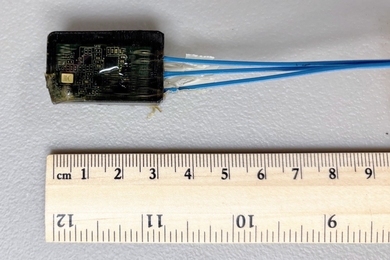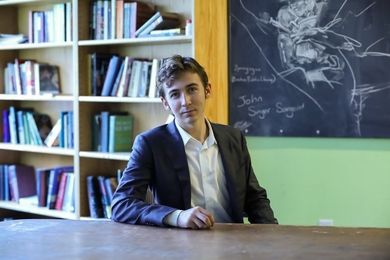John W. Dower, the Elting E. Morison Professor of History, has been awarded the 1999 National Book Award (general or nonfiction) for Embracing Defeat: Japan in the Wake of World War II. The ceremony was held in New York on November 17.
"After spending more than 10 years researching and writing about defeat, it was disorienting but decidedly pleasant to be unexpectedly 'embracing victory,'" Professor Dower wryly observed following the black-tie banquet ceremony. He thanked the National Book Foundation for its vigorous efforts to promote and enlarge the "treasure house of words" that makes it possible for historians to try to reconstruct the past.
"This National Book Award is a tremendous honor, one of many that John has received over the years for his historical writing and for documentary film. To see his name associated with History at MIT warms my heart," said Philip S. Khoury, dean of the School of Humanities and Social Science.
"Professor Dower is one of the most remarkably gifted scholars of modern Japan and a true public intellectual who has the courage and commitment to confront the complex issues that involve Japan and the United States," he added.
"This prestigious award gives well-deserved recognition to Professor Dower's distinguished work as a historian," said Harriet N. Ritvo, Arthur J. Conner Professor of History and head of the history section. "It shows that it is possible for serious -- even weighty -- historical scholarship to reach a broad general audience. I think I speak for all his colleagues when I say that we all take great pleasure and pride in his achievement."
Embracing Defeat, jointly published by W.W. Norton and the New Press, portrays Japan and Japanese-American relations between August 1945 and April 1952 and explores the still-rippling impact of Gen. Douglas MacArthur's top-down occupation policies on modern Japanese political and economic life.
In his book, Professor Dower sets the context for Embracing Defeat within the cycle of recent history that began in the late 1920s and essentially ended in 1989.
"When this short, violent, innovative epoch is scrutinized, much of what has been characterized as a postwar 'Japanese model' proves to be a hybrid Japanese-American model: forged in war, intensified through defeat and occupation, and maintained over the ensuing decades out of an abiding fear of national vulnerability and a widespread belief that Japan needed top-level planning and protection to achieve optimum economic growth. This bureaucratic capitalism is incomprehensible without understanding how victor and vanquished embraced Japan's defeat together," Professor Dower writes.
Professor Dower, who came to MIT in 1991, has spent part of each decade since the 1960s living, working and studying in Japan. He has written widely on modern Japanese history and culture and on US-Japan relations. His 1986 book, War Without Mercy: Race and Power in the Pacific War (Pantheon), won several prizes, including the National Critics' Circle Award for nonfiction in the United States in 1986 and the Masayoshi Ohira Memorial Prize in Japan.
Professor Dower has also been widely recognized for his scholarly and innovative use of visual materials and of other expressions of popular culture in re-examining Japanese history.
He has published books on Japanese design and Japanese photography as well as on the collaborative "Hiroshima Panels" by two Japanese painters, Iri Maruki and Toshi Maruki. In 1986, he was executive producer of "Hellfire: A Journey from Hiroshima," a documentary film on the art of the Marukis, which was nominated for an Academy Award.
Professor Dower's unusually broad range of topical interests is reflected in the 12 essays included in his 1993 book, Japan in War and Peace: Selected Essays (The New Press). They analyze such subjects as war films of the 1930s and early 1940s, secret police reports about wartime rumors and graffiti, Japan's own wartime inquiries into the feasibility of building an atomic bomb, the "useful" technological and technocratic legacies of the war to postwar Japan, representations of the atomic-bomb experience by Japanese artists, and the changing image of Japan in postwar and Cold War US thinking.
Earlier in his distinguished career, Professor Dower concentrated on linkages and discontinuities between prewar and postwar Japan. His 1979 book on that topic, Empire and Aftermath: Yoshida Shigeru and the Japanese Experience, 1878-1954, became a best-seller in Japanese translation.
Embracing Defeat received prompt, enthusiastic reviews.
Writing in the New York Times Book Review, J.A.A. Stockwin, the Nissan Professor of Modern Japanese Studies at the University of Oxford, described Embracing Defeat as a "magisterial and beautifully written book... Graphic and extremely moving when he describes what it was like for an ordinary person living in Japan between 1945 and 1949."
Jacob Heilbrunn of the Wall Street Journal wrote, "Surely the most significant work to date on the postwar era in Japan. His analysis of cartoons, a genre taken very seriously in Japan, is fascinating."
John Stevenson, in his review for amazon.com, commented, "Dower's analysis of popular Japanese culture of the period -- songs, magazines, advertising, even jokes -- is brilliant, and reflected in the book's 80 well-chosen photographs. The author paints a vivid picture of a society in extremis and reconstructs the extraordinary period during which America molded a traumatized country into a free-market democracy."
Positive reviews also appeared in Japan Times, Foreign Affairs, the Far Eastern Economic Review, the New Yorker and The Nation.
Embracing Defeat was a finalist for both the Lionel Gelber Prize for best book on international relations and the Kiriyama Pacific Rim Book Prize in nonfiction.
Professor Dower is a Fellow of The American Academy of Arts and Sciences. He received the BA from Amherst College and the MA and PhD from Harvard University. At MIT, he was the Henry R. Luce Professor of International Cooperation from 1991-96. Courses he teaches cover the full range of Japanese history from ancient to modern times. His expertise in visual representation is reflected in such offerings as "World War II in Asia: Film Fantasy, Fact" and "Japan in the Age of the Samurai: History and Film."
A version of this article appeared in MIT Tech Talk on November 24, 1999.





